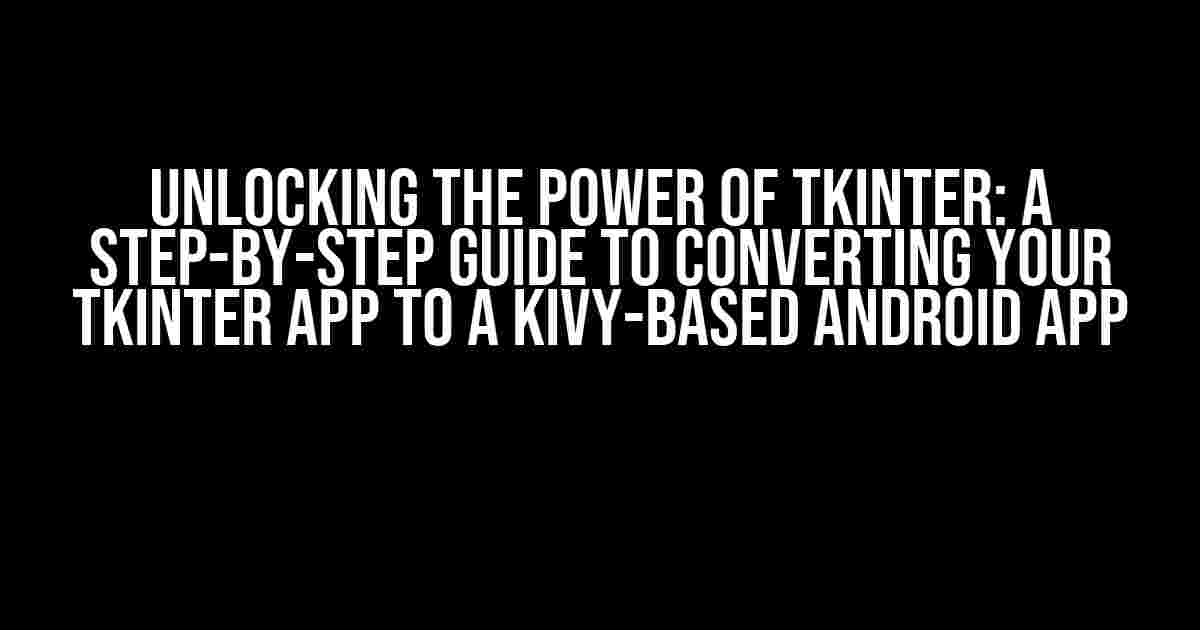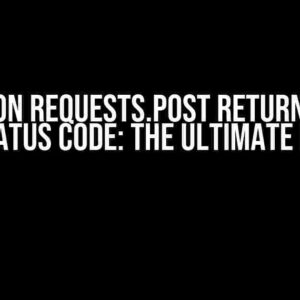Are you a talented Python developer with a passion for creating stunning GUI applications using Tkinter? Have you ever wondered how to take your Tkinter app to the next level and deploy it on Android devices? Look no further! In this comprehensive guide, we’ll take you on a journey to convert your Tkinter app to a Kivy-based Android app, empowering you to reach a wider audience and unlock new possibilities.
- Understanding the Why: Tkinter Limitations and Kivy Advantages
- The Translation Process: A High-Level Overview
- Step 1: Understand Tkinter Code Analysis
- Step 2: Learn Kivy Basics
- Step 3: Translate Tkinter Code to Kivy
- Step 4: Set up Kivy Project Structure
- Step 5: Build and Deploy to Android
- Conclusion
Understanding the Why: Tkinter Limitations and Kivy Advantages
Tkinter, although an excellent GUI toolkit, has its limitations when it comes to mobile app development. It’s primarily designed for desktop applications and lacks the flexibility and compatibility required for mobile devices. Kivy, on the other hand, is a cross-platform GUI framework that allows you to create mobile apps with a native look and feel. By converting your Tkinter app to Kivy, you’ll gain:
- Cross-platform compatibility (Android, iOS, Windows, macOS, and Linux)
- Native look and feel on mobile devices
- Access to device features like GPS, camera, and accelerometer
- Faster performance and efficient memory management
- A larger audience reach through the Google Play Store and Apple App Store
The Translation Process: A High-Level Overview
The journey from Tkinter to Kivy involves understanding the fundamental differences between the two frameworks. We’ll break down the process into manageable steps, ensuring a smooth transition for your Tkinter app.
Tkinter App → (Step 1: Understand Tkinter Code) → Tkinter Code Analysis
|
|
v
Tkinter Code Analysis → (Step 2: Learn Kivy Basics) → Kivy Fundamentals
|
|
v
Kivy Fundamentals → (Step 3: Translate Tkinter Code) → Kivy Code Translation
|
|
v
Kivy Code Translation → (Step 4: Set up Kivy Project) → Kivy Project Structure
|
|
v
Kivy Project Structure → (Step 5: Build and Deploy) → Android App Deployment
Step 1: Understand Tkinter Code Analysis
In this step, we’ll delve into the inner workings of your Tkinter app, identifying the essential components, such as:
- Widgets and their properties (labels, buttons, entries, etc.)
- Layout management (pack, grid, place)
- Event handling and bindings
- Variable and data management
Take the time to review your Tkinter code, and make notes on the following:
import tkinter as tk
class MyApp:
def __init__(self, master):
self.master = master
self.master.title("My Tkinter App")
# Create widgets
self.label = tk.Label(master, text="Welcome to my app!")
self.label.pack()
# Create event handler
def button_click(event):
print("Button clicked!")
# Create button
self.button = tk.Button(master, text="Click me!", command=button_click)
self.button.pack()
root = tk.Tk()
app = MyApp(root)
root.mainloop()
Step 2: Learn Kivy Basics
Kivy is built upon a different architecture than Tkinter. Familiarize yourself with Kivy’s:
- Widget hierarchy and tree
- Layout management ( BoxLayout, GridLayout, etc.)
- Event handling and dispatching
- Property management and bindings
Start with Kivy’s official documentation and tutorials to get a solid grasp of the framework. Some essential Kivy concepts to master include:
from kivy.app import App
from kivy.uix.label import Label
from kivy.uix.button import Button
from kivy.uix.boxlayout import BoxLayout
class MyApp(App):
def build(self):
layout = BoxLayout(orientation='vertical')
label = Label(text='Welcome to my app!')
button = Button(text='Click me!')
layout.add_widget(label)
layout.add_widget(button)
return layout
if __name__ == '__main__':
MyApp().run()
Step 3: Translate Tkinter Code to Kivy
Now it’s time to translate your Tkinter code to Kivy. We’ll focus on:
- Converting widgets and their properties
- Adapting layout management
- Migrating event handling and bindings
- Updating variable and data management
Using the Tkinter code analysis from Step 1, begin translating your widgets and layout:
from kivy.uix.label import Label
from kivy.uix.button import Button
from kivy.uix.boxlayout import BoxLayout
class MyApp(App):
def build(self):
layout = BoxLayout(orientation='vertical')
# Create label
self.label = Label(text='Welcome to my app!')
layout.add_widget(self.label)
# Create button
self.button = Button(text='Click me!')
layout.add_widget(self.button)
return layout
Step 4: Set up Kivy Project Structure
In this step, we’ll set up a Kivy project structure, including:
- Creating a `main.py` file
- Configuring the `buildozer.spec` file
- Organizing resource files (images, fonts, etc.)
Create a new directory for your Kivy project and add the following files:
| File/Folder | Description |
|---|---|
| main.py | Main application file |
| buildozer.spec | Buildozer configuration file |
| resources/ | Folder for images, fonts, etc. |
Step 5: Build and Deploy to Android
The final step is to build your Kivy app and deploy it to Android devices using Buildozer. You’ll need:
- Buildozer installed on your system
- A Java Development Kit (JDK) installed
- An Android SDK installed
Run the following command in your terminal:
buildozer init
Edit the `buildozer.spec` file to include the necessary settings for your app. Then, run:
buildozer android debug
This will create a debug APK file in your project directory. Install it on your Android device and test your app!
Conclusion
You’ve successfully converted your Tkinter app to a Kivy-based Android app! Pat yourself on the back, and get ready to share your creation with the world. Remember to continuously test and improve your app to ensure the best user experience.
By following these steps, you’ve not only migrated your app to a new platform but also gained a deeper understanding of Kivy and its capabilities. The possibilities are endless, and the future of your app is brighter than ever.
Happy coding, and see you on the Google Play Store!
Here are 5 Questions and Answers about “tkinter to Android app” with a creative voice and tone, using HTML:
Frequently Asked Question
Get ready to transform your tkinter app into a stunning Android application with these FAQs!
Can I directly convert my tkinter app to an Android app?
Unfortunately, no. Tkinter is a Python library for building GUI applications, while Android apps require native Android code. You’ll need to use a framework like Kivy to translate your tkinter app into an Android-compatible format. But don’t worry, we’ve got you covered!
What’s the best way to translate tkinter to Kivy?
The easiest way is to rewrite your tkinter app using Kivy’s Python API. You can also use tools like tk2kivy, which can automatically translate some parts of your tkinter code into Kivy. However, be prepared to do some manual tweaks to get everything working smoothly.
Will I need to learn new programming languages for Android development?
Not necessarily! With Kivy, you can stick to Python and focus on building your app’s logic. Kivy takes care of the underlying Android code for you. However, having some knowledge of Java and Android’s SDK can be helpful if you want to customize your app further.
Can I use my existing tkinter design in my Android app?
Yes, you can! Kivy allows you to reuse your existing tkinter design with some modifications. You can also use Kivy’s built-in widgets and layouts to create a more native Android look and feel. Just be prepared to adapt to Kivy’s unique syntax and design principles.
How long does it take to convert a tkinter app to an Android app using Kivy?
The conversion time depends on the complexity of your app, your experience with Kivy, and the amount of manual tweaking required. On average, it can take anywhere from a few days to several weeks to get your app up and running on Android. But trust us, it’s worth the effort!








